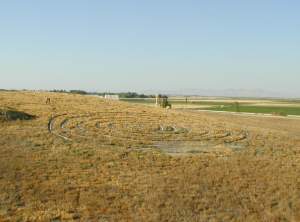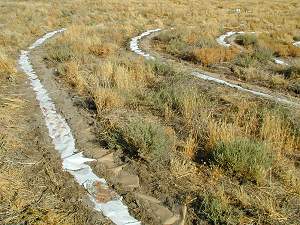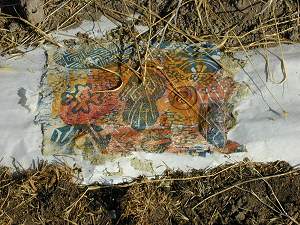Turning Through Time: Communication with the distant past at Çatalhöyük
Adrienne MomiHow can we learn about the religious impulse of preliterate cultures? One way is to allow the images made in that culture to speak. The wall paintings at Çatalhöyük appear to describe mythic stories, and religious practices of the people who settled in that area, and have tantalized me from my first viewing of them. Not only do these paintings offer clues to the rituals associated with hunting at Çatalhöyük, but they also suggest that myth-making may extend back at least 8,000 years.
One way to understand the meaning of art is to make art about that art. Because of my previous work at Neolithic sites in Central Europe, I was invited to add my voice as a professional artist and mythologist to the multidisciplinary interpretation of Çatalhöyük during the season of 2001. There, I created a monumental spiral that not only delved into the past, but also told us something important about the present. My methodology consists of creating temporary installations on archaeological sites, often in collaboration with local artists. The intention is to "listen" to the land with a sensitive earto hear the myths that may reveal themselves. Part of the collective unconscious, they tell the stories of the people who lived in that landscape.
Each installation tells a different story in a different way. The spiral at Çatalhöyük, "Turning Through Time," echoes some of the geometry in the wall paintings, examines the possible ritual meaning of those images, and also sheds light on the mythic structure of the contemporary scholars working there. It was a delight to enlist the collaboration of both the local children and the scholarly interpretive team in order to complete this project. "Turning Through Time" is a fine example of interdisciplinary study as well as an important window into the religious practices of the past.
As you read the following artists statement, imagine standing at the crest of the mound, looking down on at a 50 metre-wide spiral.

Figure 21: 'Turning Through time", installation by Adrienne Momi 2001
"Nestled among the vegetation on the shallow southeast slope of Çatalhöyük, Turning must be "found" by the viewerjust as the archaeologists must find their clues to the past civilization they study here.
The spiral is an ancient symbol with many interpretations. Turning Through Time is a bi-directional spiral, created with two colors of paper. It focuses our awareness inward toward the ancient civilization that lies buried beneath Çatalhöyük, and outward toward the contemporary scholarship that seeks to understand those early people.
Fashioned out of brown and white paper, the revolutions of Turning Through Time represent the plastered walls in the houses buried beneath the soil. The printed handmade paper "bricks" which are layered onto the "walls" echo the images found in the wall paintings.
 |
 |
| Figure 22: 'Turning through Time', installation by Adrienne Momi, details. | |
Turning Through Time describes yet another spiral path: the process of knowledge making at Çatalhöyük. Following the hermeneutic circle, scholars visit and revisit concepts and data resulting in new or refined information revealing itself each time the spiral of interpretation revolves.
As you stand within Turning Through Times arcs, notice that you can have only a limited sense of its totalityjust as we have only a limited sense of the totality of the life and the landscape that existed below this mound so many millennia ago."
Dr. Adrienne Momi is a scholar of world mythologies, a print maker, and a paper maker whose work has been exhibited internationally. Recently, she has used the medium of temporary monumental paper installations in order to focus on how mythologies of the ancient past continue to affect us today. Dr. Momis installations have previously been experienced in California, Missouri, the Czech Republic, and now in Turkey.